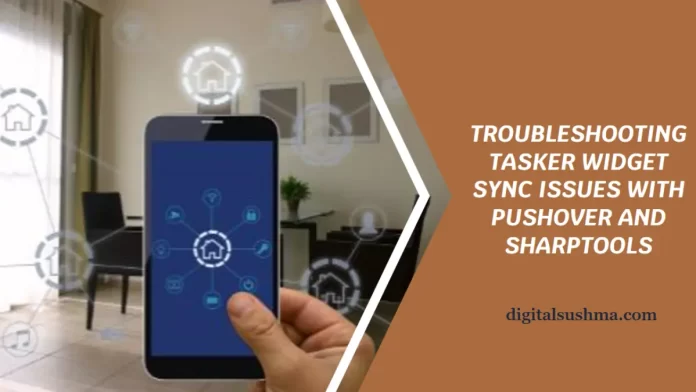In the ever-evolving world of home automation, Tasker has emerged as an indispensable tool for users looking to customize and automate various household processes. This versatile app allows you to create personalized scripts and widgets to control your smart home devices and appliances. However, many enthusiasts encounter frustrations when trying to sync their Tasker widgets with third-party apps like Pushover and SharpTools.
In this comprehensive guide, we will demystify the intricacies behind Tasker widget syncing issues. You will gain insights into the root causes of sync failures and learn actionable troubleshooting tips to resolve them effectively. Whether you are just starting out or looking to optimize an existing setup, read on to ensure seamless integration between Tasker, Pushover and SharpTools.
Understanding Tasker, Pushover and SharpTools
Before jumping into troubleshooting techniques, let’s first build a foundational understanding of these three critical apps and their core functionalities:
Tasker – This highly customizable automation app empowers users to set up personalized scripts and widgets to control various tasks. From scheduling routines to creating home automation workflows, Tasker provides endless possibilities.
Pushover – This notification management app serves as a central hub for your phone alerts and notifications. It supports real-time delivery of notifications from Tasker and other services.
SharpTools – Acting as a smart home dashboard, SharpTools allows you to monitor and control internet-connected devices from a unified interface. Users can build custom dashboards and integrate widgets from services like Tasker.
Syncing the widgets between these three apps is pivotal for an efficient home automation system. When effective syncing fails to happen, your notifications, alerts and remote access capabilities get disrupted.
Also Read: The Complete Guide to Publix Passport Login: Tips for US Employees
Importance of Syncing Tasker Widgets
So why is it so important to ensure proper syncing between Tasker, Pushover and SharpTools? Here are some key reasons:
- Real-time notifications – Syncing supports instant alerts from Tasker to be delivered via Pushover. Without sync, notifications are delayed.
- Remote access and monitoring – The integrated dashboard provided by SharpTools relies on timely data feeds from Tasker. Sync failures can lead to incomplete dashboard information.
- Unified control – Being able to control devices from Tasker, Pushover and SharpTools provides convenience. But the apps need to be in sync for harmonized control.
- Automation workflows – Many advanced home automation routines rely on sequenced syncing between apps like Tasker and SharpTools. Syncing issues can break these workflows.
- Convenience and efficiency – Fundamentally, syncing provides a convenient singular interface for your home automation system. Trouble-free syncing enhances the efficiency of your smart home.
Diagnosing Common Syncing Issues
Now that you grasp the gravity of syncing your Tasker widgets, let’s explore some of the common syncing issues users face:
- Delayed or missing notifications – Notifications created in Tasker fail to sync instantly with Pushover, leading to delays or absence of alerts.
- Dashboard loading failures – When widgets don’t sync properly, the SharpTools dashboard displays loading errors or gets stuck.
- Incomplete data transfer – Due to sync failures, device statistics and sensor data from Tasker do not fully transfer over to SharpTools.
- Device control failures – When apps lose sync, device commands from Tasker or SharpTools fail to execute properly.
- Automation failures – Intricate home automation workflows relying on sequenced Tasker-SharpTools syncing break down completely.
- Resource overload – Too many widgets and excessive background processes connected to Tasker can overload resources and cause sync failures.
While the exact issues may vary for different users, diagnosing the problems associated with failed Tasker widget syncing is an important first step toward resolving them.
Also Read: Login To NYC Citytime And Reset Your Password
Troubleshooting Tasker Widget Syncing
Once you have identified the specific syncing issues based on symptoms, it’s time to methodically troubleshoot and tackle the root causes. Follow these best practices:
Confirm Network Connectivity
Having a stable internet connection is the foundation for any kind of app syncing. Check that Wi-Fi connectivity is strong in the locations where your apps need to sync. Also, ensure your router firmware is updated.
Update All Apps to Latest Versions
Staying updated with the newest app versions minimizes software-related syncing bugs. Check the Google Play Store or App Store for pending Tasker, Pushover and SharpTools updates. Install them immediately.
Review App Permissions
Syncing issues can arise if Tasker lacks the permissions to transfer data with Pushover and SharpTools. Navigate to the app permission settings on your Android or iOS device and confirm the right permissions are enabled.
Adjust Tasker Settings
Dive into the Tasker app settings and tweak configurations that impact syncing:
- Reduce widget refresh rate – Frequent widget refreshes can congest syncing traffic.
- Enable background data usage – Allows Tasker syncing to occur even when the app is not in foreground.
- Adjust parallel task limit – More concurrent tasks can deplete system resources, affecting sync.
Reconfigure Pushover Notifications
Check your Pushover notification settings for Tasker profile. Turn off battery optimization, enable persistent notifications, adjust priority and retry intervals. This facilitates uninterrupted sync.
Optimize Your SharpTools Dashboard
Overloaded SharpTools dashboards with too many widgets and data fields will hamper syncing performance. Try simplifying your dashboard by removing nonessential items.
Leverage Community Resources
The official Tasker community forums and Reddit threads offer a wealth of shared wisdom on tackling syncing issues. Participate and learn from others who have faced similar challenges.
Consider Compatibility Constraints
If apps have certain version incompatibilities, particularly with new OS versions, syncing may fail. Check forums/release notes for specific compatibility information between Tasker, Pushover and your Android/iOS version.
Also Read: How to Activate Disneyplus.com Login/Begin 8-digit Code
Tasker Widget Best Practices
Beyond troubleshooting your current setup, applying these Tasker widget optimization best practices will safeguard seamless syncing:
- Simplify widgets by limiting number of data fields
- Avoid overly complex widgets with too many updating elements
- Use leaner widgets on battery-powered devices like smartphones and tablets
- Always select a reasonable widget refresh interval, like 30 mins for most use cases
- Limit the number of active background processes linked to a given widget
- Assign widgets selectively to system profiles like Home vs Away modes
- Incorporate sync failure contingency workflows with actions like SMS alerts
Advanced Techniques for Expert Users
For tech-savvy users willing to get their hands dirty, several advanced techniques can give you granular control over Tasker widget syncing:
- Custom scripting using JavaScript lets and Tasker’s Java APIs to manipulate sync behavior
- Using third-party plugins like AutoShare to extend Tasker’s capabilities
- Leveraging REST APIs and webhooks to create custom connections between Tasker and target apps
- Root access on Android devices opens a wider range of sync optimization tweaks and plugins
While most users will not need these methods, they provide experienced power users extreme flexibility. However, it requires diligent testing.
Also Read: A Complete Guide to Activating the Oxygen Channel App on Streaming Devices
Key Takeaways from the Tasker Community
With thousands of active members, the Tasker user community provides valuable insights into real-world challenges faced while syncing widgets:
- Battery optimization is notorious for disrupting Tasker-Pushover syncing on Android devices. Disable it.
- iOS users cannot disable battery optimization as on Android. So Pushover notifications often get delayed.
- Using the Notify action rather than Notify Pushover action has proven more reliable for some users.
- Adding a brief Wait action between actions sometimes helps with sync timing issues.
- shapetools recently revamped their API leading to breaking changes. This has caused many sync failures.
Staying active on forums keeps you updated with solutions to emerging Tasker widget syncing issues.
What Does the Future Hold?
As home automation explodes in popularity, we can expect more homes and devices becoming Tasker-controlled. The developers are expected to further optimize their apps for reliability and performance.
Some upcoming improvements that can augment Tasker widget syncing include:
- Enhanced cross-platform support between Android and iOS
- More integration with IFTTT and other automation services
- Support for MQTT protocol for more resilient device communications
- Evolution of Google Assistant and Siri for greater smart home device control
The key is to stay updated on your Tasker ecosystem apps by checking release notes, reviews and community chatter.
Also Read: Download and Activate the Watch OWN App on Multiple Devices
Real-World Success Stories
To inspire you to persist and solve your Tasker widget syncing woes, here are some encouraging real-world success stories from the community:
“I was ready to ditch Tasker because of unreliable syncing with Pushover. But optimizing permissions did the trick and now notifications are lightning-fast!”
“SharpTools integration was completely broken after updating to iOS 14. I was stuck for 2 weeks! Turns out a simple widget reconfiguration fixed it.”
“My highly complex morning automation routine failed daily due to Tasker-SharpTools sync failures. Adding wait actions of just 3-5 seconds between steps resolved it wonderfully.”
The key takeaway is perseverance pays off. There will always be a solution to Tasker widget sync






